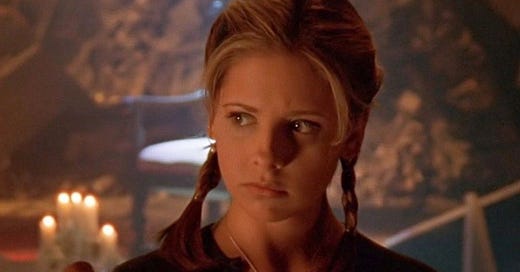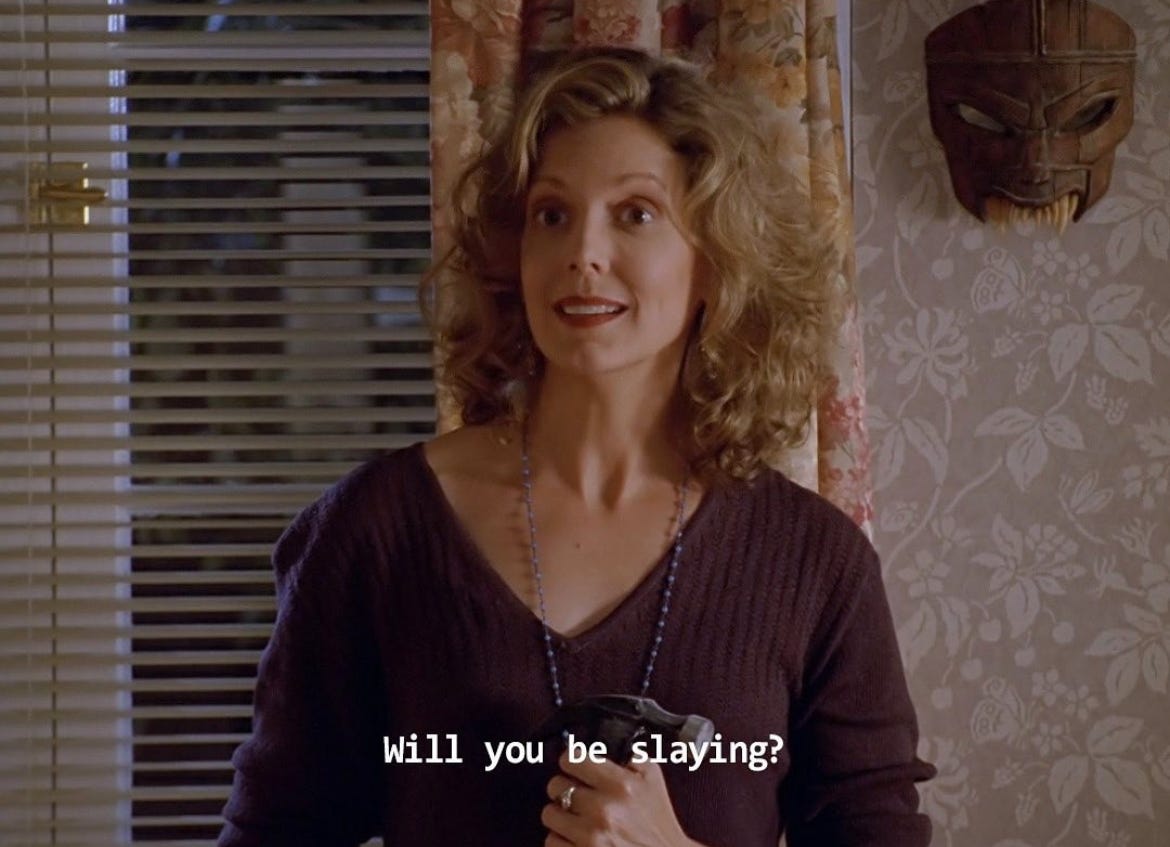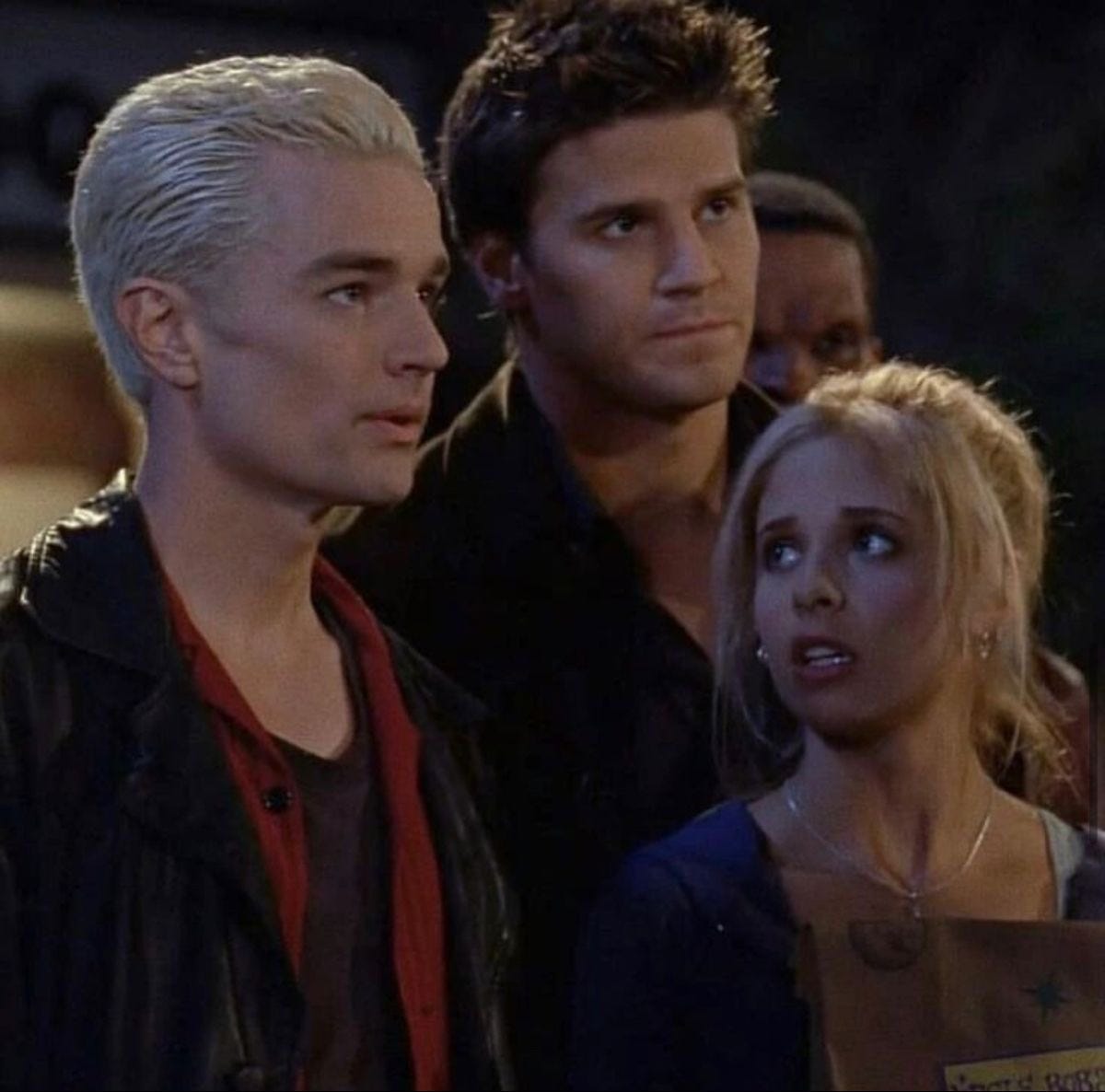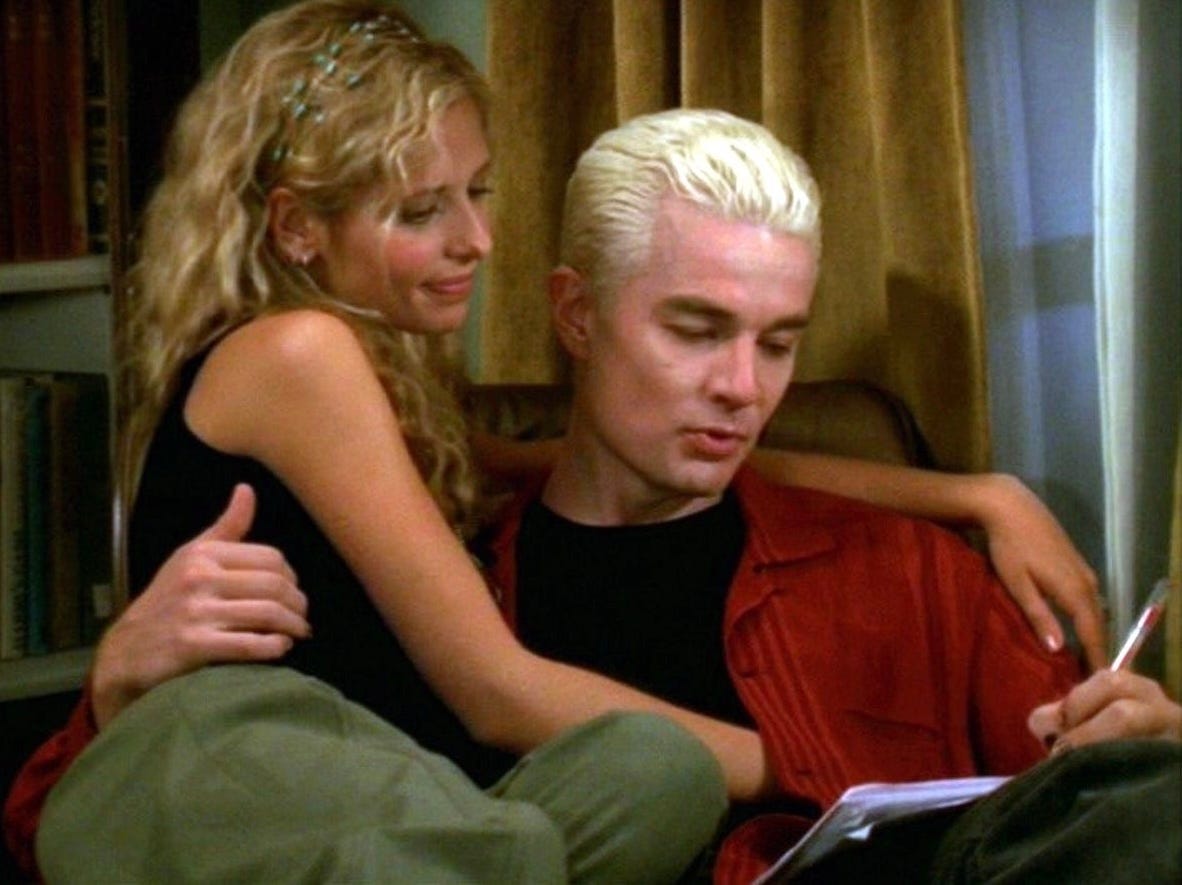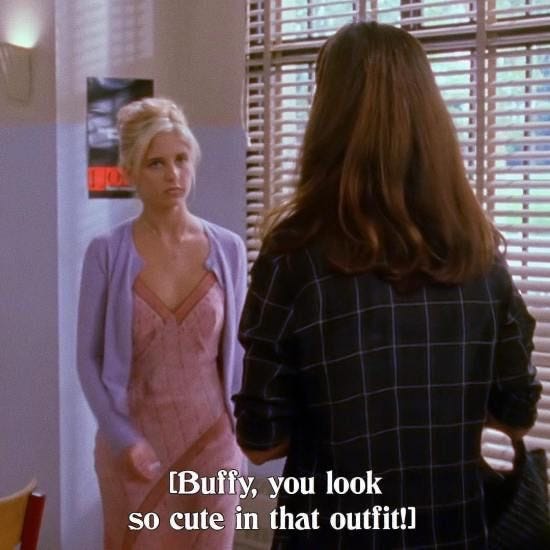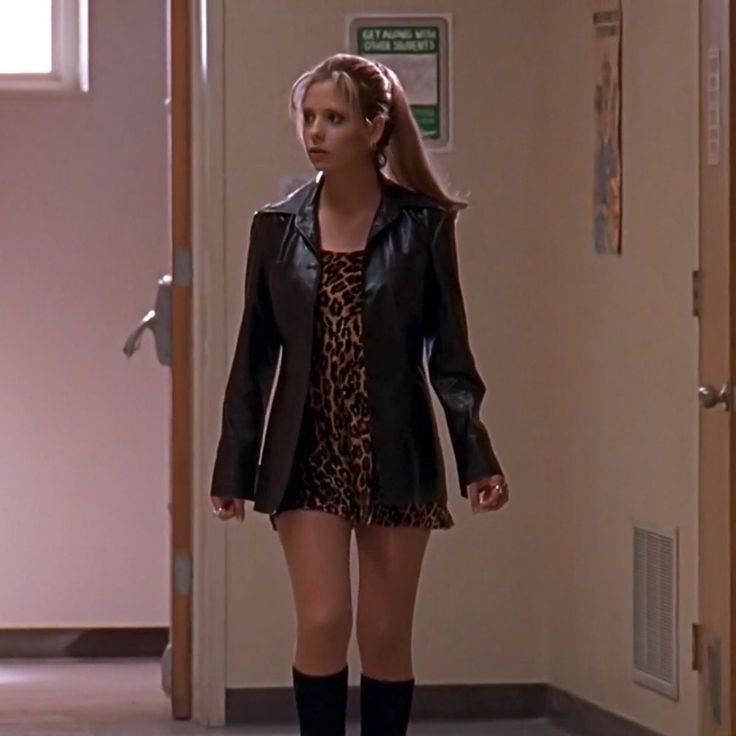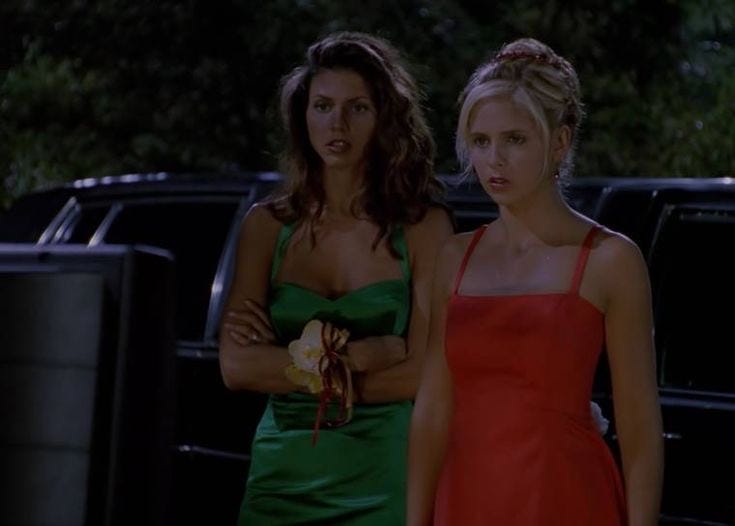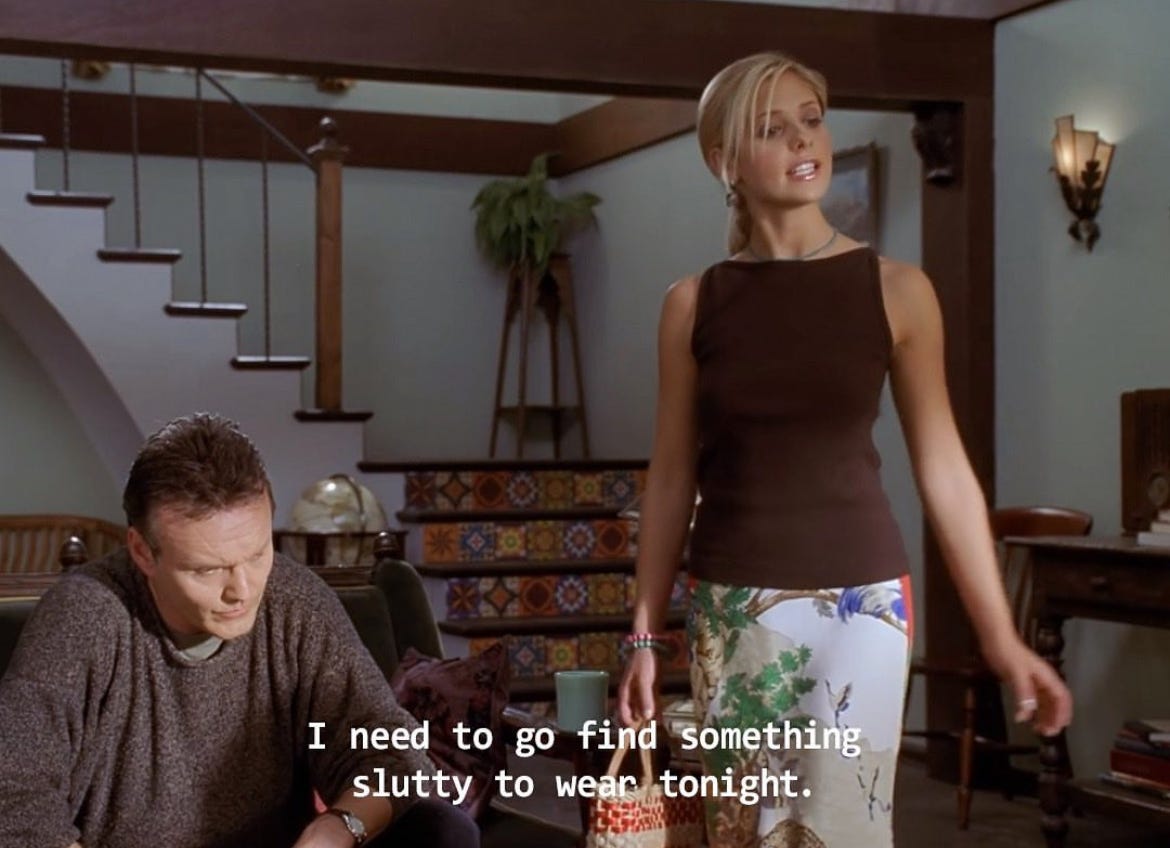She came, she slayed, she saved the world (a lot).
Celebrating Buffy the Vampire Slayer and her impact on fashion, feminism and pop culture, decades later.
Have you ever watched a show with a well-written female protagonist? Seen an on-screen lesbian relationship? Used the phrase ‘Google it’? You have Buffy the Vampire Slayer to thank for that and so much more.
The show has been celebrated for so many reasons since its first episode aired in March 1997 on the WB. Based on the film of the same name, the show has faced more publicity and controversy after creator Joss Whedon was revealed to have created a “toxic work environment’ on the show’s set, as well as more of his high-profile productions. Despite Whedon’s behaviour and sometimes questionable writing of his female characters (Justice for Cordelia Chase and furthermore her actress charisma carpenter- who once reposted a fan edit I made, so, yk, I’m basically famous), Buffy is constantly credited as a major milestone in feminism, horror tropes and television in general. Buffy Summers was the girl who could do it all, and she did. The show ran for six seasons across two networks. She died, came back to life, saved the world, had multiple vampire boyfriends, gained and lost family, wore some of the best outfits a teen girl has worn on television, worked a minimum wage fast food job, and oh, yeah- Slayed Vampires! Guys, it’s time for a deep dive. Of course, spoilers ahead.

Buffy Summers, the it girl of the millennium.
When the show premiered on March 10th 1997, It was never expected to be a hit. Based on the 1992 film of the same name, the show was a mid-season replacement for the cancelled show Savannah. The film had been unsuccessful, so why would anybody expect the show to perform any differently?
The show ran for seven seasons, the first five airing on the WB and the remaining two on UPN. Buffy herself, Sarah Michelle Gellar, was already an Emmy winner before the show began and the most notable of the cast. The core group of the show was the Scoobies, comprising of Buffy and best friends Willow and Xander (Buffy and Willow being the only characters to appear in all episodes). Rupert Giles, the school librarian, is also Buffy’s ‘watcher’, someone sent to protect and watch over Buffy. Throughout the series, the ‘Scooby gang’ grows in size, adding characters including high school popular girl Cordelia Chase, werewolf and boyfriend of Willow- Oz, former vengeance demon Anya, Willow’s girlfriend Tara Mclay, Buffy’s younger sister Dawn Summers, a second slayer called Faith and, of course, Angel and Spike, two vampires with feelings for buffy.
I could write for days in-depth about every one of these characters, their influence on the show and in real life (specifically Willow and Tara, one of the first examples of an on-screen lesbian relationship and the very first example of a lesbian sex scene on TV). The series had a successful spin-off, Angel, which ran for five seasons and 110 episodes from October 1999 through to May 2004. The spin-off featured many prominent characters from Buffy, such as Cordelia and Faith, as well as new faces. It had a much darker tone compared to Buffy and is apparently considered one of the best TV spin-off shows of all time (which, despite my love for most of the show, could definitely be debatable)
By the way, ‘Buffy studies’ is a real thing. You can really read academic papers based solely on the show and the universe surrounding it.
Vampires, Virginity and Vivid nightmares of discovering your boyfriend is a dick.
Of course, no TV show works without a central romance. Although the writers tried in the high school seasons to give the other scoobies a chance to shine in relationships, The Oz-Willow-Xander-Cordy storyline didn’t hold a candle to what most of its audience wanted, Buffy and Angel. The chosen one and the reformed vampire, the brooding older guy with the main teenage lead, the Romeo and Juliet of it all. I personally didn't care for the couple the way some did. I found angels relationship with Cordelia in his spin-off show to be much more interesting, and Buffy had a much more interesting relationship with a different vampire later on in the show... but that being said, Buffy and Angel were the centre of the show, most specifically its second season.
Season 2 of Buffy began to delve deeper into Buffy and Angel’s relationship. Their first kiss had already happened in season 1, and their love blossomed in season 2. Well, for the first half of season 2, anyway. On the night of her 17th birthday, Angel admits his love for Buffy before the pair have sex, and Buffy loses her virginity to him. For Angel, this is a moment of true happiness, the only issue there being that Angel’s ‘curse’ of having a soul would be broken if he could ever experience true happiness (the assumption being he would feel too much guilt about his past actions to ever feel happy). So they have sex, Angel loses his soul, turning him back into a cruel monster, one of the most notorious vampires of all time. Whilst that is happening, Buffy is fast asleep, only to wake up and discover that the man she just lost her virginity to is nowhere to be found. It was her first time, but she knew it wasn’t his. Oblivious to the whole soul issue, an insecure buffy sees Angel again later on in the episode. Without his soul, he is much more charismatic but also, obviously, evil. Upset, she asks him if the reason he’s no longer interested in her is because she was bad in the bedroom. His response- yes. The scene is genuinely awful to watch, even if you don’t like them as a couple, his play on Buffy’s insecurities is psychological torture. In short, girl loses her virginity to someone she thought she trusted and loved, just to find out he’s a prick who seemingly just wants to get some and be done with it, that she wasn’t a good shag and is now seen as unimportant. The nightmare of many a teenage girl.
The metaphor is on the nose. I know.
Buffy finds out what has actually happened with Angel and the soul situation later in the episode, and in the rest of the season, Angel is the main villain. Some melodramatic episodes and amazing performances from Sarah Michelle Gellar, later, Buffy kills Angel in the season finale- despite her feelings for the version of him she fell in love with. His death isn’t permanent, and he returns as his sad, souled self in season 3. The pair date again, but by the end of season 3, Angel realises Buffy needs to try to live a partially normal life, and he isn’t helping her with that. He leaves Sunnydale for good and moves to LA, leaving Buffy to, again, pick up the pieces without him.
In later seasons, Buffy’s main love interest is Spike, the bad-boy vampire with bleached hair and a British accent. Their relationship is first played as a joke in the season 4 episode ‘Something Blue’, where a spell gone wrong leaves Buffy and Spike planning a wedding together. After the spell wears off, their relationship remains in a ‘frenemies’ zone for a while. Eventually, Spike realises his feelings for Buffy, and by the end of the series, his feelings are fully reciprocated. Their relationship has many more ups and downs than Buffy’s relationship with Angel. Spike, who remains soulless till the final season, shows his feelings for Buffy in a much more obsessive way. When the pair finally start a more physical relationship, there is a violent and aggressive nature to their sexual relations- to the point that they destroy a whole building by just having sex (it sounds weirder than it is.) This storyline is another thinly veiled metaphor for Buffy’s self-destructive emotions whilst she is at her lowest. This ends in another heartbreaking scene, this time in the episode ‘Seeing Red’ where spikes violent, evil nature, leads him to attempt to sexually assault Buffy. She saves herself and kicks him out of her home, prompting him to leave Sunnydale and have his own soul restored. The final season gives the pair of them more closure, having them in a much more platonic relationship until the series finale. With his soul, spike stood by Buffy and believed in her when no one else did, ultimately sacrificing himself for her cause. In their final scene together, Buffy confesses her love for him, spike replies, “No, you don’t, but thanks for saying it.”
Potentially, there is an element of surprise to find out the show ended with Buffy not having a romantic partner (the comics are a whole other thing guys, just… don’t), but it makes the most sense. The show displays time and time again that Buffy is strong with or without a partner in her life and that, honestly, all the men in her life caused her more issues. Although I would have loved the show to have ended with Buffy and Spike together, it only feels right that she departed Sunnydale with her friends and family after saving the world, not just being reduced to a romantic cliche.
Sidenote: Spike’s sacrifice is cheapened when they immediately revive him in Angel, so it's probably best to ignore that.
Slaying the supernatural creatures, one amazing outfit at a time.
Buffy Summers has influenced generations of young girls to be brave, face their fears, and look good doing it. Although her hairstyle may never have had the cultural importance of ‘the Rachel’ haircut, Sarah Michelle Gellar’s amazing blonde hair was central to buffy being buffy, defying all stereotypes of the dumb or weak hot blonde girl.
Her Style has remained iconic through the years, with now Instagram accounts such as @everyoutfitbuffywore and @buffytheoutfitslayer, and Twitter accounts including @BuffyLookBook, documenting her fashion choices nearly three decades on. Buffy’s style was a mix of hyper-feminine pinks, bows, florals and pastels, and more dark, grungey leather jackets and trousers, regularly topped off with boots, hoop earrings and her signature cross necklace.
As recently as two years ago, publications like Vogue have been writing about the clothes Buffy wore on screen. Maybe it’s just because trends cycle around and the 2020s are just rehashing the fashion of the 90s and 00s, or maybe her style is truly just timeless.
Episodes that changed everything.
Buffy The Vampire Slayer had its fair share of genre-defining episodes, as well as episodes that are just so good that they have achieved iconic status. ‘Hush’, the seventh episode of season 4, is a legendary one. A group of terrifying demons come to Sunnydale and steal everyone’s voices. A fully silent episode with more horrifying visuals than most episodes makes it seem like inspiration for the 2018 film ‘ A Quiet Place'.’
When you think of a musical episode, does ‘Once more, with feeling’ ever cross your mind? The season 6 episode is one of the first truly modern examples of a television musical episode (meaning you have the show to blame for Owen Hunts singing in that Grey’s episode). The musical element of the episode isn’t just a gimmick either; it shows the true feelings of the core characters in ways normal speech never could after all of them have faced a pretty tough time. The entire episode has fully original music, and, fun fact: I have the CD for it. A feat for episodic storytelling- it’s always worth the watch.
(Also, not to make this about a man, but Angel did an episode where Angel was turned into a puppet, and I truly think that show deserves its own article.)
‘Innocence’, the season two episode I mentioned in relation to the metaphor of sex and virginity, is often grouped with the best episodes of the show, however less for its narrative storytelling and more for the performance it gave. In a similar vein, the season five episode ‘The Body’ doesn’t have any profound or unique narrative devices, it’s one of the most human episodes of the show. Buffy’s mother, Joyce, passes away, but there is no supernatural involvement. The episode just focuses on the characters facing a death no one can be blamed for, nor could it have been prevented. In its simplest form, it’s a display of grief- with no music used in the episode to sober up the otherwise dramatic show.
Just because an episode is bold doesn’t mean it’s an automatic fan favourite. In season 6, the episode ‘Normal Again’ asks the age-old TV show question- what if none of this is real? The episode proposes that Buffy is, in fact, in a psychiatric hospital, and everything that has come previously is simply a delusion. It’s another haunting episode, furthered by the fact that its ending is left open, never certainly stating if Sunnydale is real or simply part of Buffy’s deteriorated mental state, leaving fans divided.
‘The Gift’ is the season five finale and could have been the series finale had UPN not taken the show on for its further seasons. It shows Buffy making the ultimate sacrifice for her friends and family, dying to save the rest of their lives. Although she had died in the season one finale as well, this death wasn’t a brief one. The episode ends with Buffy dead and everybody mourning her. When she eventually is revived in season 6, it’s not quick and easy. She has to dig herself out of her own grave after being ripped out of heaven. It’s dark, and it would have been a very different way to have ended the show.
Buffy has truly lived on for generations. Viral Twitter (or should I say X) accounts such as @buffys, @retrocvnty and @btvsarchive amas thousands of interactions on buffy-related tweets every day, the Twitter fandom for it where I met so many of my online friends is as active today as it has ever been. It may have ended 21 years ago, but buffy summers will stay on forever.
Thank you for reading this whole post, it means the world to me <3. This is definitely my longest post to date, and I’ve loved writing every word. If you want more buffy content, I’m borderline obsessed and would love to write more, or maybe you want my thoughts on other shows- either way, let me know!
Oh and don’t forget…
Buffy The Vampire Slayer is now avaliable to stream in full for free on Tubi.


